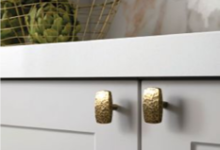
Kitchen Safety Tips to Avoid Fire Hazards
Kitchen safety is extremely important because a kitchen can be a dangerous place. With its stoves, cooktops, microwaves and ovens, fires can start and burn injuries can occur. While kitchens can be dangerous, they don’t have to be when you’re aware of the dangers and take steps to avoid them. Smart safety practices can keep your family safe when you’re using the kitchen.
The following tips can help prevent kitchen fires and property damage, like a house fire.
Kitchen Fire Hazards
Cooking in the kitchen requires using the stove and oven, and these appliances can present a fire hazard in different ways. Fire hazards while cooking can be prevented with well-maintained appliances, proper safety procedures and by never leaving food unattended.
It’s also helpful to understand the various ways kitchen fires begin.
Grease.
Cooking oils like olive oil, vegetable oil and animal fat all have flash points, the temperature at which the fat or oil will catch fire. Before oils reach their flash point, they first reach their smoke point, the point at which oils start to smoke. When the oil starts smoking, it’s easy to identify when an oil is getting too hot.
Oils heated to a hot enough temperature can start a fire. Therefore, when deep-frying something, the temperature should be monitored at all times to avoid a grease fire.
Here’s a few other ways to avoid starting a grease fire:
- Taking the oil off the heat if it starts to smoke.
- Placing the lid on oil that is at risk for catching fire and allowing the oil to cool naturally.
- Heating oil slowly when cooking.
Electrical Wiring.
Faulty electrical equipment can be another source of kitchen fires. Countertop appliances become fire hazards when their cords are accidentally melted in flames from the stovetop.
Cords and wires should be checked for damage before using. Unusual smells while cooking, like the smell of rubber burning or plastic melting, are definite warning signs.
Stove and appliance wiring should be inspected periodically to avoid accidents. If the wiring does become damaged, stop using that appliance and make repairs as soon as possible.
Clutter, Clothing and Jewelry.
Clutter, storage boxes, clothing and jewelry can all become safety hazards in the kitchen. They are more than just tripping hazards; they can also block the evacuation route if a fire breaks out.
Kitchen fires can spread fast, and when kitchen fires occur, time is of the essence. Therefore, people should maintain safe and clear evacuation routes throughout their kitchen. Walkways should be kept clear at all times.
Loose clothing, jewelry and long hair can catch fire during cooking. Don’t wear long sleeves and dangly necklaces while cooking. And pull back and tie up your long hair when cooking.

Kitchen Safety Tips for Preventing Burns
Here’s our tips for preventing burns:
- Use oven mitts.
- Stand back when removing a lid from a hot liquid.
- Never blend hot liquids in a blender.
- Hold the pot away when draining hot pasta.
- Position pots on the stove so the handles are positioned over the stove or counters, not over the front of the stove.
Types of Burns and How to Treat Them
Despite your best efforts, burns do occasionally occur.
First-degree Burns.
A first-degree burn is a relatively superficial burn that will go away in a matter of days with proper care. They cause pain and reddening of the skin but no blisters. To care for a first-degree burn, run the affected area under cool water and keep it clean and covered with a sterile gauze.
You can also apply aloe vera to a minor burn. Aloe vera is a natural remedy for minor burns and wounds. It’s full of active compounds that can help reduce pain and inflammation and aid in the repair of burned skin.
Second-degree Burns.
You’ll know you have a second-degree burn if you get blisters. Blisters can pop and get infected. Treat a second-degree burn similarly to first-degree burns, but use a medicated ointment to treat the blisters.
Third-degree Burns.
Third-degree burns are very serious and require immediate medical attention. These burns go through the outer layer of skin and affect deeper tissues. You’ll see white or blackened skin. Pain is intense. Call 9-1-1.

How to Put Out Kitchen Fires
The best method for putting out a kitchen fire depends on where the fire is and what started it. A fire needs oxygen and fuel to keep burning, so the methods for putting out fires involve cutting off oxygen or fuel.
Every kitchen should have a fire extinguisher (rated B for grease fires).
Your family members should know where the fire extinguisher is located and how to use it. Fire extinguishers can expire, so they should be checked regularly. The dial can also indicate when a fire extinguisher needs to be replaced.
Oven and Broiler Fires.
If a kitchen fire starts in the oven, turn it off and back away. Don’t open the oven, as this will provide oxygen for the fire, which could cause it to expand rapidly.
If the fire starts to spread, call the fire department and leave the area immediately. If the fire remains contained in the oven, stay there until the fire has burned out. When everything has cooled off, open the oven door and start to clean up.
Stovetop Fires.
Stovetop fires are more dangerous than oven fires because they’re not contained. Keep a pot lid by the stove to use to contain a fire. Remember, lack of oxygen will put out the fire. If there is no lid, pour an entire box of baking soda on the fire. Or use the fire extinguisher.
Don’t use water on a grease fire. Water may spread the fire around.
Kitchen Cooking Safety.
Because cooking in the kitchen involves fire and heat, it can be a dangerous process. Grease left over heat too long can reach its flash point, items left in the oven accidentally can catch fire and stirring or cooking hot liquids can lead to burns.
Cooking safely can be done by following basic rules.
Microwave.
Microwaves tend to be very safe, but some people worry about exposure to radiation when using their microwave. While problem can occur on rare occasions, it is not usually a problem if the microwave is working properly.
Burns relating to picking up hot foods from the microwave are more common.
Always use microwave-safe dishes. If something is heated in the microwave for several minutes (like a potato that is cooked for 5 minutes), use an oven mitt to lift it out.
Microwaves can heat water to beyond the boiling point, without the water ever coming to a visible boil. When this superheated water is disturbed, it can erupt from its container, leading to serious burns. Therefore, water should not be heated too quickly at a high temperature. In addition, the water should be allowed to cool before you attempt to move it.
If a microwave turns on when the door is open, it probably means the sensor isn’t working. If this happens, get your microwave repaired or replaced.
2. Oven and Stovetop.
Pay attention to warning signs such as smells of burning, melting or smoking while you’re cooking. Don’t store anything in the oven.
Use the back burners on the stove first, and use front burners only when back burners aren’t available. Pots that are too small or too big for the burner should be avoided. Never leave an empty pan on an active burner.
Try to keep children out of the kitchen when the stove is being used and out of the way when opening an oven door. Curious pets should be kept out of the kitchen while cooking appliances are being used, as well.
Other Kitchen Safety Tips.
- Items baking at a high temperature should be monitored
- Fire extinguishers should be nearby before deep frying
- All racks in the oven should be positioned before pre-heating
- Don’t line the oven with foil, either on the rack or underneath
- Clean up grease after cooking
- Invest in a carbon monoxide detector. Ovens can have carbon monoxide leaks.
- Always supervise the self-cleaning oven process and follow all manufacturer recommendations when using the self-cleaning function.
Conclusion
Our kitchen safety tips, coupled with caution and common sense, will keep you and your family fire- and burn-free in your newly remodeled kitchen.
———————————————–
KDP exists to offer insight and advice about all things related to kitchen remodeling. Our goal is to connect homeowners with talented, experienced kitchen designers who live and work in their communities. We are a serious resource for anyone preparing to remodel their kitchen so they can make the best possible choices about designers, contractors and products.
————————————————
Our thanks to The Ashton Real Estate Group of RE/MAX Advantage in Nashville, TN for their article on Kitchen Safety, from which we have extracted our Kitchen Safety Tips. You can read their article on their website.



